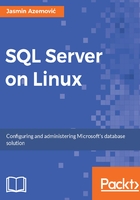
上QQ阅读APP看书,第一时间看更新
Database objects
Tables are the containers for database records. They represent basic elements of the database structure. For example, Students, Educators, Courses, and Grades can be a table in some hypothetical eUniversity system. Tables are built around data types bounded on table columns. For example, LastName - nvarchar(50), Salary - Money, BirthDate - datatime. Every data operation includes tables and some of the other database objects (listed as follows):
- Stored procedures are objects in the database for storing methods of actions. A procedure could be described as a program that processes actions in the database. For example, inserts, updates, and/or delete rows in a table.
- Functions are objects in the database that encapsulate formulas and calculations and return either scalar values, or sets of data.
- Views are an object that consists of one select-statement, and are referenced as a table. Normalized database views bring normalized data together and masks complex table structures.
- Schemas are an organizational object and can be described as a folder in a filesystem. All objects in a database must belong to a schema.
- User-defined objects are objects that consist of an interpretation of a native SQL Server data type and offer a standardized method of describing the value of columns, variables, and parameters.